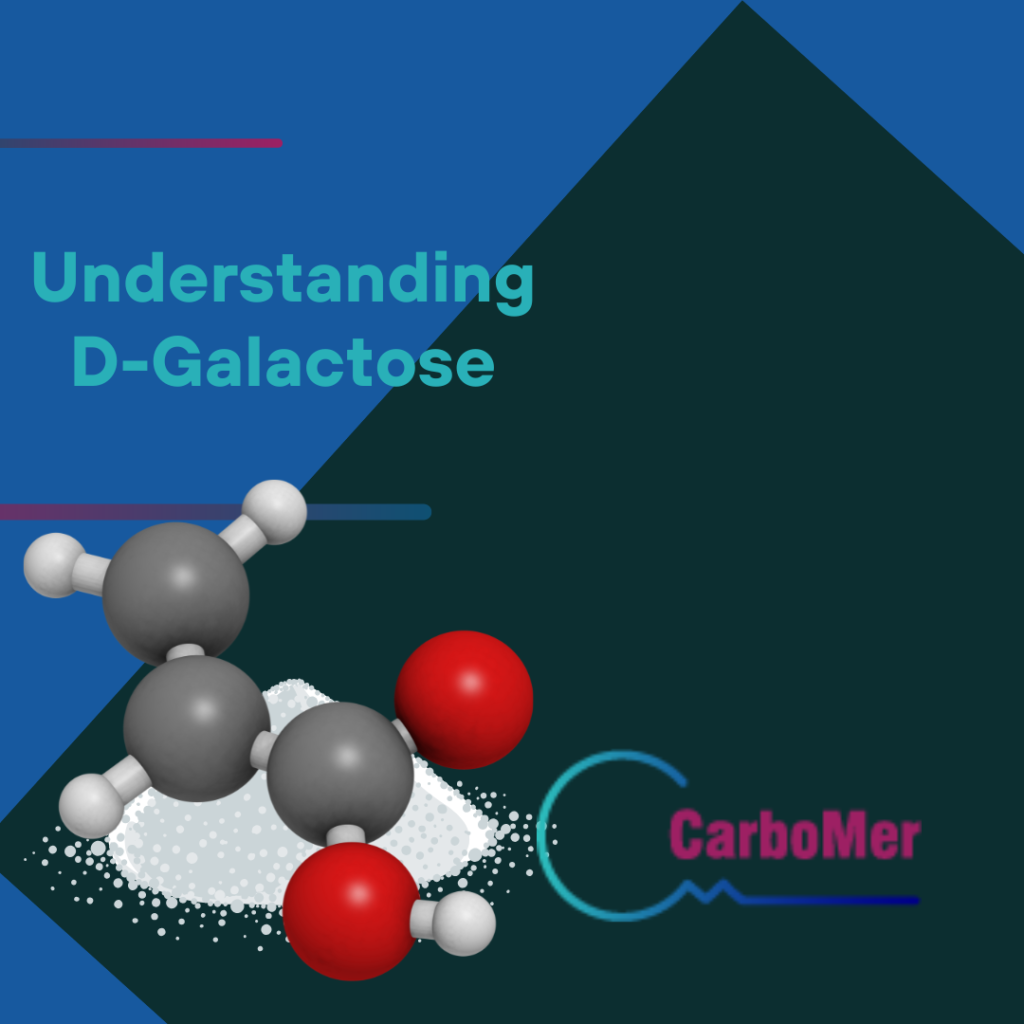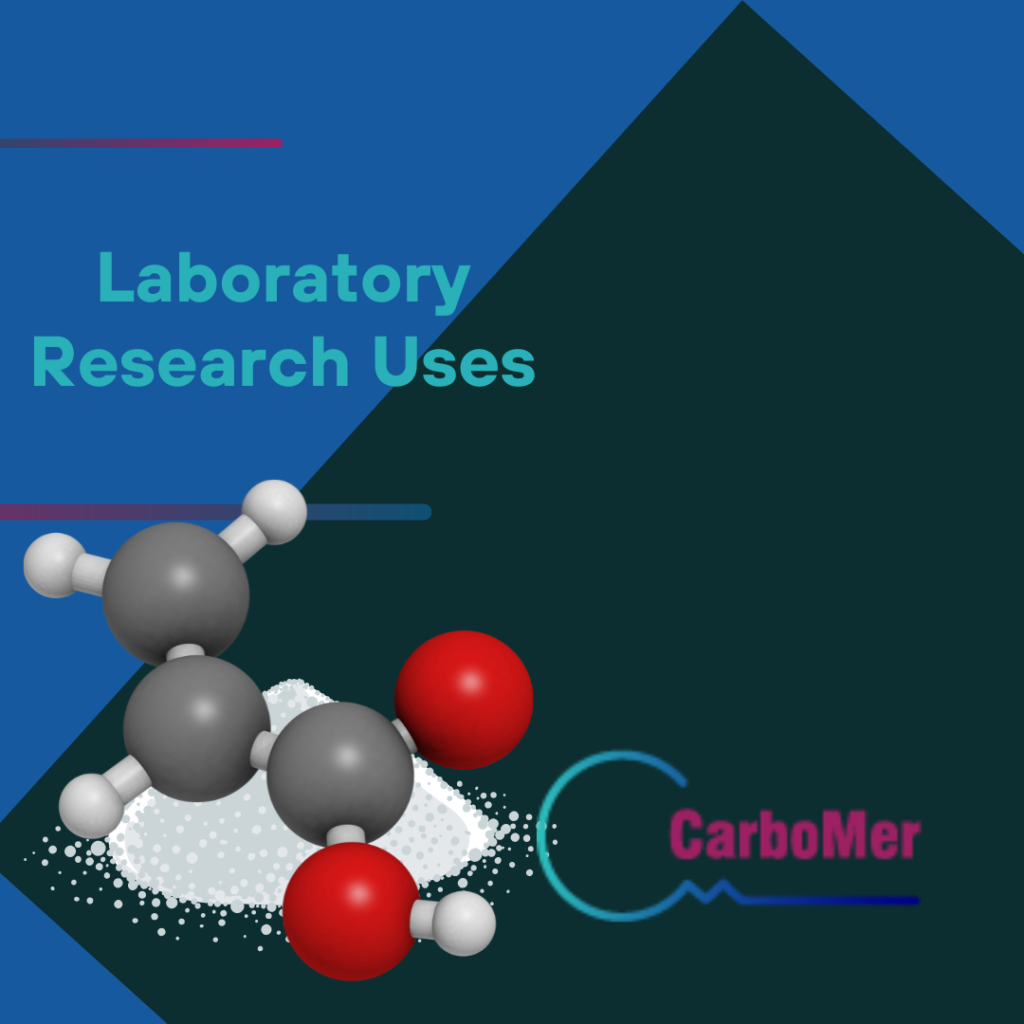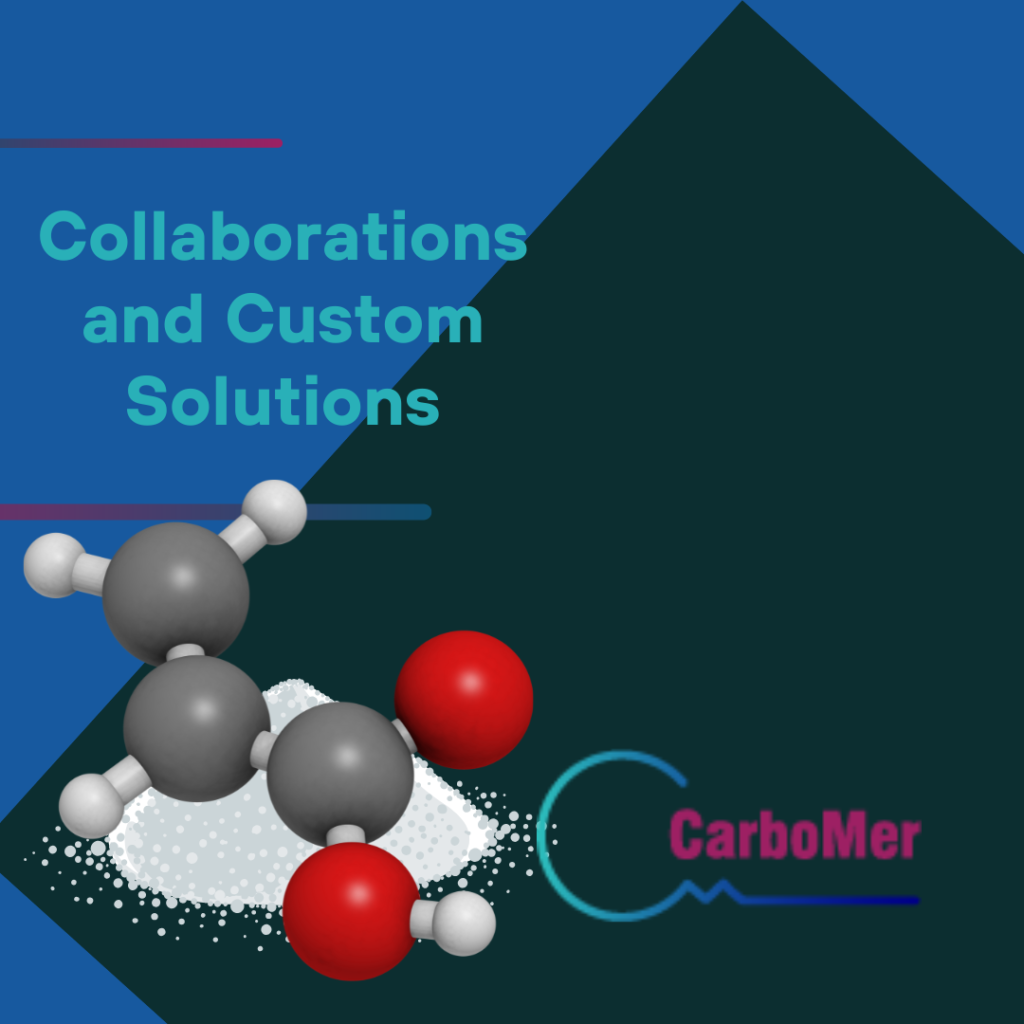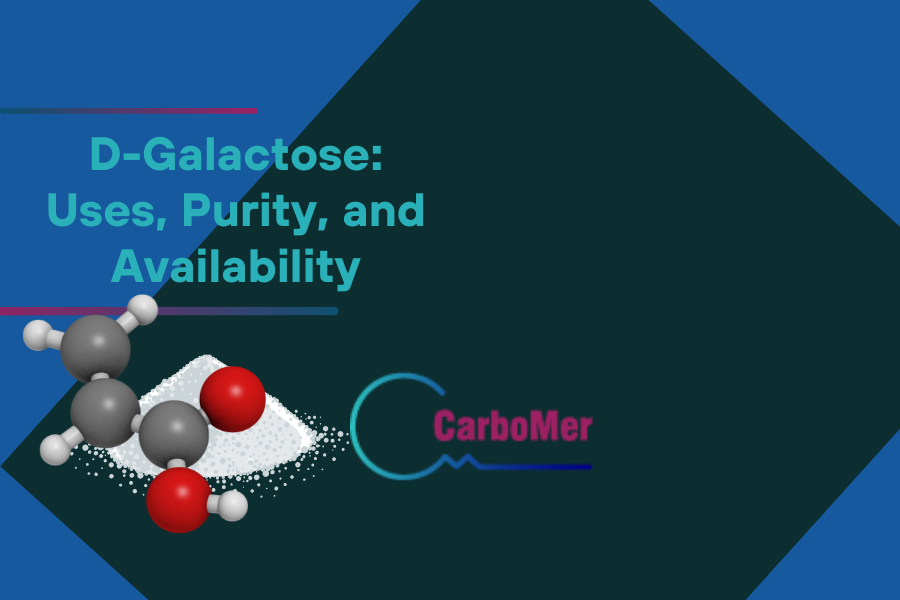D-Galactose is a simple sugar integral to many biological and industrial processes. In biology, it forms part of the disaccharide Lactose and is crucial in metabolism. Research uses it to study neurodegeneration and aging. Industry leverages it for sweeteners and biodegradable materials. This article explores D-Galactose’s roles in metabolism, its research and industrial applications, and its clinical significance. In pharmaceuticals it is used in drug formulation and delivery systems.
Key Takeaways
- D-Galactose is a versatile monosaccharide essential for metabolism and found in Lactose; it plays a key role in energy production through the Leloir pathway.
- Its applications span research—especially in studying neurodegeneration and oxidative stress—and industry, where it is used in producing sweeteners and biodegradable materials.
- CarboMer, Inc. offers high-purity D-Galactose (98%) with a focus on regulatory compliance, advanced technologies for improved properties, and collaborations for innovative product development.

Understanding D-Galactose
D-Galactose, with its chemical formula C6H12O6, is a simple monosaccharide sugar that exists in both open-chain and cyclic forms. As a reducing sugar, it can donate electrons, playing a crucial role in various biological processes. This monosaccharide is a fundamental component of Lactose, the disaccharide sugar found in milk and is integral to many complex carbohydrates.
Biologically, D-Galactose is a C-4 epimer of D-Glucose, meaning they differ only in the orientation of the hydroxyl group on the fourth carbon atom. This slight variation is significant, as it influences how D-Galactose is metabolized and utilized within the body.
Recognizing the unique properties of D-Galactose allows for a better grasp of its roles in metabolic pathways and industrial applications.
How is D-Galactose Produced
D-Galactose can be obtained from the breakdown of Lactose, a sugar found in dairy products. The digestive enzyme Lactase breaks down Lactose into Glucose and Galactose. Other sources include milk, sugar beets, gums, and mucilages and Arabinogalactans, which are derived from plants.
The Role of D-Galactose in Metabolism
Galactose metabolism is a critical component of cellular function, primarily facilitated through the Leloir pathway. This metabolic route involves the enzymatic conversion of D-Galactose into glucose-6-phosphate, a pivotal molecule in energy production. The three principal enzymes driving this process are galactokinase (GALK1), galactose-1-phosphate uridylyltransferase (GALT), and UDP-galactose 4’-epimerase (GALE), where D-Galactose is converted enzymatically into glucose-6-phosphate.
The liver significantly contributes to this metabolic conversion, transforming D-Galactose into D-Glucose for energy production and other cellular activities. Effective metabolism of D-Galactose is crucial for maintaining cellular energy balance and overall metabolic health.
Applications of D-Galactose in Research and Industry
D-Galactose’s versatility extends beyond metabolism, finding valuable applications in both research and industry. In laboratory settings, it serves as a crucial tool in studying various biological processes, including blood cells and neurodegenerative diseases in the human body. Its ability to mimic aging processes and induce oxidative stress makes it a key substance in ongoing studies.
D-Galactose produced for biopharmaceutical applications meets the highest quality and purity standards. It has been utilized as a key component to optimize protein production while reducing lactate and ammonia formation. Among the various benefits imparted by Galactose in bioproduction are: reduced Lactate production and elevated target protein production.
In the industrial realm, it is used as a sweetener and thickening agent in various food products, enhancing flavor without significantly increasing calories. In pharmaceuticals it acts as an excipient in drug formulations, improving the stability and bioavailability of active ingredients. In biotechnology it serves as a substrate in fermentation processes, such as in the production of probiotics and other beneficial microorganisms. Its research uses include studies of carbohydrate metabolism and cellular signaling, providing insights into various metabolic disorders. In cosmetics Galactose is incorporated in skincare products for its moisturizing properties, helping to maintain skin hydration and improve texture.
D-Galactose is a fundamental ingredient in the synthesis of sweeteners like Xylitol and Tagatose, highlighting its importance in the food industry. Moreover, its role in the production of biodegradable materials and crosslinked polymers showcases its potential in creating sustainable industrial solutions.

Laboratory Research Uses
In laboratory research, D-Galactose is frequently employed to investigate the mechanisms underlying neurodegeneration and oxidative stress. Notably, cell lines such as human neuroblastoma SH-SY5Y and mouse neuroblastoma Neuro2a have been treated with D-Galactose to study its effects on cellular viability and function. These studies often utilize assays like the MTT assay to evaluate cell viability and metabolic activity.
Chronic exposure to D-Galactose has been linked to accelerated aging and cardiovascular issues, making it a valuable model for studying age-related diseases. Inducing oxidative damage-related cellular damage, D-Galactose offers insights into the biological processes behind aging and neurodegeneration.
Industrial Applications
In the industrial sector, D-Galactose is essential for the synthesis of crosslinked polymers, contributing to the creation of durable and biodegradable materials. Its incorporation into polyacrylic acid formulations has led to the development of materials with enhanced water retention and biodegradability.
D-Galactose also serves as a precursor for synthesizing bioactive compounds, aiding advancements in industrial biotechnology. As a building block for various industrial processes, D-Galactose showcases its versatility and importance in developing innovative and sustainable solutions.
Clinical Significance of D-Galactose
The clinical significance of D-Galactose extends to its potential health impacts and therapeutic uses. Collaborations with cosmetic and pharmaceutical companies aim to develop high-performance formulations that boost product efficacy and consumer experience. These partnerships emphasize the innovative potential of D-Galactose in various medical and therapeutic applications.
Ongoing research and development projects aim to harness the unique properties of D-Galactose to improve health outcomes and therapeutic interventions. Exploring its clinical relevance helps us understand how this versatile sugar molecule can advance medicine and healthcare.
Potential Health Impacts
Deficiencies in the enzymes responsible for galactose metabolism can lead to serious health conditions, such as galactosemia. This genetic disorder results from mutations in the GALT, GALK1, and GALE genes, causing severe metabolic issues. The accumulation of Galactitol, a byproduct of D-Galactose metabolism, can lead to cataracts in affected individuals.
Research has shown that chronic exposure to D-Galactose induces oxidative stress and accelerates aging, providing valuable insights into the mechanisms of neurodegeneration and age-related diseases. These studies often utilize animal models to mimic the aging process and evaluate the effects of D-Galactose on cellular aging and oxidative stress.
Therapeutic Uses
Exogenous D-Galactose is being studied for its potential in enhancing vaccine effectiveness and treating kidney diseases. Research suggests that incorporating D-Galactose into vaccine formulations may improve immune responses and overall vaccine efficacy.
Additionally, D-Galactose’s biochemical properties are being investigated for therapeutic interventions in kidney diseases, highlighting its potential to enhance immune responses and support treatment outcomes. These ongoing studies underscore the therapeutic promise of D-Galactose in various medical applications.
CarboMer’s D-Galactose Offerings
CarboMer, Inc. is committed to providing high-purity D-Galactose products that meet the diverse needs of its clients. With a purity of over 98% (as determined by HPLC analysis) CarboMer ensures that its D-Galactose products are of the highest quality and purity. This high purity is crucial for various applications, from research to food and industrial processes.
CarboMer aims to partner with clients to meet their strategic objectives by providing expert knowledge, reliable service, and unique products. By providing high-quality D-Galactose, CarboMer supports progress in research, industry, and therapeutic applications.
Product Purity and Availability
CarboMer’s D-Galactose achieves a purity level of 98%, verified through rigorous HPLC testing. This high purity ensures that the product is suitable for sensitive applications in research and industry, where impurities can significantly impact results.
Additionally, CarboMer offers D-Galactose in various forms to cater to the specific needs of different applications. Whether for laboratory research, industrial processes, or therapeutic interventions, CarboMer’s D-Galactose is available in the formats required to achieve optimal results.
Proprietary Technologies
CarboMer uses proprietary technologies to improve the solubility, stability, and bioavailability of D-Galactose. These technologies are crucial for improving the effectiveness of D-Galactose in various formulations, ensuring that it performs optimally in different applications.
Utilizing specialized methods, CarboMer significantly improves the solubility and stability of D-Galactose, facilitating its use in diverse pharmaceutical and industrial products. These advancements underscore CarboMer’s commitment to innovation and quality in its product offerings.

Collaborations and Custom Solutions
CarboMer collaborates with leading cosmetic and pharmaceutical companies to develop innovative product formulations and solutions. These partnerships integrate advanced technologies into CarboMer’s offerings, enhancing product efficacy and consumer experience.
Additionally, CarboMer offers custom organic synthesis services tailored to the unique needs of clients in the beauty and healthcare industries. Providing bespoke solutions, CarboMer helps clients achieve their specific components objectives and innovate in their fields.
Regulatory Compliance and Quality Assurance
Adhering to regulatory guidelines is critical for ensuring the safety, efficacy, and quality of D-Galactose products. CarboMer’s pharmaceutical chemicals are produced in compliance with FDA, CBER, EMA, and Personal Care Products Council guidelines. This adherence to stringent regulations underscores the company’s commitment to quality and safety.
Maintaining open communication with regulatory authorities and ensuring accurate documentation are vital for successful regulatory submissions. CarboMer’s dedication to regulatory compliance and quality assurance ensures that its products meet the highest standards in the industry.
Summary
D-Galactose is a multifaceted molecule with significant roles in metabolism, research, industry, and clinical applications. Its involvement in Galactose metabolism via the Leloir pathway, its utility in laboratory and industrial settings, and its clinical relevance highlight its importance across various domains. CarboMer’s high-purity D-Galactose products and proprietary technologies further enhance its applications, ensuring quality and efficacy.
In summary, D-Galactose is a vital component in numerous biochemical and industrial processes. CarboMer’s commitment to providing high-quality products and innovative solutions underscores the potential of D-Galactose in driving advancements in science and industry. We encourage you to explore the diverse applications of D-Galactose and its contributions to your field.
Frequently Asked Questions
What are the effects of D-Galactose?
D-Galactose can induce brain aging through mitochondrial dysfunction, increased oxidative stress, inflammation, and apoptosis, ultimately leading to cognitive decline. These effects highlight the importance of understanding its impact on brain health.
What are some proprietary technologies offered by CarboMer?
CarboMer’s proprietary technologies focus on improving drug bioavailability, solubility, and stability, along with applications in diagnostics. These advancements are crucial for enhancing pharmaceutical effectiveness.
What types of collaborations does CarboMer engage in?
CarboMer engages in collaborations with leading cosmetic and pharmaceutical companies focused on product formulation and development. This allows them to leverage expertise and innovation in these industries.
GALACTOSE PRODUCTS
CARBOMER, INC.’S GALACTOSE PRODUCTS
CarboMer, Inc.’s offers D-Galactose as a pharmaceutical grade that is manufactured under cGMP; it is EP and USP monograph compliant. These products are all manufactured under cGMP conditions, with compliance to USP/EP monographs.
These products include:
8,04795 D-Galactose EP/USP[59-23-4] high purity, endotoxin-controlled
3,02780 D-Galactose USP [59-23-4] plant derived, GMP grade, endotoxin-controlled
SELECTED NON-PHARMACEUTICAL D-GALACTOSE AND RELATED PRODUCTS OFFERED BY CARBOMER INC.
CarboMer offers several D-Galactose and related products. Some of these products include:
3,00279 D-Galactose [59-23-4]
3,00017 L-Galactose [15572-79-9]
3,00197 1,5-Anhydro-D-galactose [644-76-8]
3,00223 Acetobromo-a-D-galactose [3068-32-4]
3,00224 Acetobromo-b-D-galactose [572-09-8]
3,00067 Penta-O-acetyl-a-D-galactopyranoside [4163-59-1]
3,00195 Penta-O-acetyl-b-D-galactopyranoside [4163-60-4]
3,00296 1,2:3,4-Di-O-isopropylidene-a-D-galactopyranose [4064-06-6]
3,00274 D-Galactonic acid calcium salt pentahydrate [69617-74-9]
3,00275 D-Galacturonic acid [91510-62-2]

